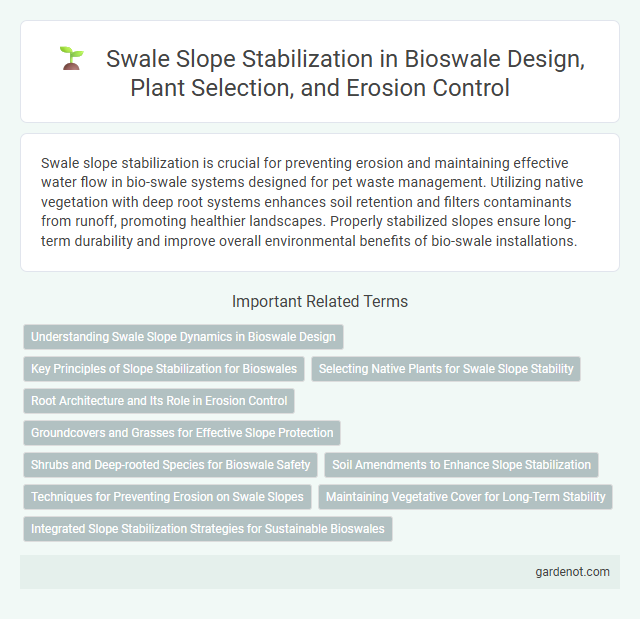Swale slope stabilization is crucial for preventing erosion and maintaining effective water flow in bio-swale systems designed for pet waste management. Utilizing native vegetation with deep root systems enhances soil retention and filters contaminants from runoff, promoting healthier landscapes. Properly stabilized slopes ensure long-term durability and improve overall environmental benefits of bio-swale installations.
Understanding Swale Slope Dynamics in Bioswale Design
Swale slope stabilization is critical in bioswale design to manage surface water runoff velocity and prevent erosion. Understanding swale slope dynamics involves analyzing soil type, infiltration rates, and slope gradient to maintain structural integrity and promote effective water filtration. Optimized slope design enhances sediment capture, encourages vegetation growth, and maximizes bioswale efficiency in stormwater management.
Key Principles of Slope Stabilization for Bioswales
Effective slope stabilization for bioswales relies on maintaining gentle slopes, typically between 2% and 5%, to minimize erosion and promote proper water infiltration. Strategically planting deep-rooted native vegetation enhances soil cohesion while facilitating stormwater absorption, preventing runoff. Incorporating engineered elements like check dams and erosion control blankets supports soil retention and slope integrity, ensuring bioswale durability.
Selecting Native Plants for Swale Slope Stability
Selecting native plants for swale slope stabilization enhances soil retention by leveraging deep root systems adapted to local soil and climate conditions. Native species such as switchgrass (Panicum virgatum) and black-eyed susan (Rudbeckia hirta) improve infiltration and reduce erosion on swale slopes. Their resilient root networks promote sediment capture and support long-term bio-swale functionality.
Root Architecture and Its Role in Erosion Control
Root architecture plays a critical role in swale slope stabilization by enhancing soil cohesion and reducing erosion rates. Extensive root systems, particularly from native grasses and deep-rooted shrubs, bind soil particles and increase infiltration capacity, mitigating surface runoff. Understanding root depth, density, and distribution within bio-swales improves their effectiveness in controlling slope erosion and promoting sustainable water management.
Groundcovers and Grasses for Effective Slope Protection
Groundcovers and grasses play a crucial role in swale slope stabilization by reducing soil erosion and enhancing water infiltration. Deep-rooted species such as native fescues, creeping juniper, and buffalo grass bind soil particles, minimizing surface runoff and promoting slope integrity. Integrating drought-tolerant groundcovers like sedum and creeping thyme further ensures continuous vegetation cover, sustaining soil structure and slope durability under varying environmental conditions.
Shrubs and Deep-rooted Species for Bioswale Safety
Swale slope stabilization relies heavily on planting shrubs and deep-rooted species to enhance soil retention and prevent erosion in bioswales. These plants improve structural integrity by anchoring soil with their extensive root systems, reducing runoff velocity and increasing infiltration rates. Selecting native, drought-tolerant deep-rooted shrubs maximizes bioswale safety by promoting long-term slope stability and ecosystem resilience.
Soil Amendments to Enhance Slope Stabilization
Soil amendments such as compost, biochar, and organic matter significantly improve swale slope stabilization by increasing soil structure, water retention, and nutrient availability. These amendments promote robust root growth and microbial activity, which enhance soil cohesion and reduce erosion on bio-swale slopes. Incorporating tailored soil amendments optimizes slope stability and sustainability in bio-swale systems.
Techniques for Preventing Erosion on Swale Slopes
Techniques for preventing erosion on swale slopes include vegetation planting, mulching, and installing erosion control blankets. Deep-rooted native plants effectively stabilize soil by reducing runoff velocity and increasing infiltration. Geotextiles and check dams further reinforce swale slopes by minimizing soil displacement during heavy rainfall events.
Maintaining Vegetative Cover for Long-Term Stability
Maintaining vegetative cover is crucial for swale slope stabilization by reducing soil erosion and enhancing water infiltration rates. Deep-rooted native grasses and plants anchor soil effectively, preventing slope failure and promoting natural nutrient cycling. Consistent monitoring and replanting ensure long-term stability and resilience against extreme weather events in bio-swale systems.
Integrated Slope Stabilization Strategies for Sustainable Bioswales
Integrated slope stabilization strategies for sustainable bioswales combine vegetation, engineered structures, and soil amendments to prevent erosion and enhance water retention. Deep-rooted native plants strengthen soil structure while permeable geotextiles and coir mats reduce surface runoff and sediment displacement. Employing layered approaches promotes long-term stability, improves stormwater management, and supports ecological resilience in bioswale systems.
Swale slope stabilization Infographic

 gardenot.com
gardenot.com